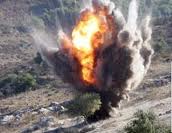Lebanon Remembers Thwarting "May 17 Agreement"

Source: Al-Manar TV, 19-5-2008
In 1983, Lebanon was recovering from a fierce "Israeli" war launched on it under the pretext of crushing the Palestinian resistance. That same year, Lebanon nearly became the second Arab state to sign a peace deal with the "Israeli" entity, or did it?
On the 17th of May 1983, then Lebanese President Amin Gemayel, now a key figure in the so called Cedars Revolution, represented by Antoine Fattal, signed the deal with the "Israelis"; a deal that was thwarted one year later by a popular uprising.
At that time "Israel" needed the deal to achieve its other goals. The United Stated represented by its envoy Philippe Habib granted "Israel" its wish. Negotiations kicked off on December 28, 1982. Thirty five rounds of talks were held alternately between the Lebanon Beach Hotel in the "Israeli" occupied Khalde region and a ballet hall near the settlement of Kiryat Shmona in occupied Palestine. From the first round of talks, the "Israelis" never left any detail for coincidence; they even imposed the shape of the negotiations table, literarily.
The term "normalization" was not mentioned in the text of the agreement that stated on forming a joint contact committee to hold regular meetings in Lebanon and ""Israel"". The committee was given the mission of developing bilateral relations, including controlling the movement of imports and exports, individuals, etc.
The Lebanese delegation sought to renounce some terms, which made the agreement look like a peace agreement, fearing Lebanon would be boycotted as was the case in Egypt. So the deal was given the name "The "Israeli" withdrawal agreement." Yet it implicitly ended the state of war which was declared against "Israel" since the establishment of the Zionist entity in 1948.
The agreement gave "Israel" the right to form a security zone in south Lebanon controlled by 4341 soldiers from both Lebanese and "Israeli" armies. Local forces, according to the text, would protect the zone, in an indication to the collaborating forces of Saad Haddad. The deal determined the nature of the Lebanese army forces to be allowed to be present in this area, limiting their number to two brigades in addition to police and internal security forces.
However the deal never saw light.
A campaign of protests was launched just after parliament endorsed the bill of the agreement. In 1984 the struggle broke out and the "February 6 Uprising" forced Gemayel to take back the agreement to parliament, to be annulled on the 5th of March 1984.
In 1983, Lebanon was recovering from a fierce "Israeli" war launched on it under the pretext of crushing the Palestinian resistance. That same year, Lebanon nearly became the second Arab state to sign a peace deal with the "Israeli" entity, or did it?
On the 17th of May 1983, then Lebanese President Amin Gemayel, now a key figure in the so called Cedars Revolution, represented by Antoine Fattal, signed the deal with the "Israelis"; a deal that was thwarted one year later by a popular uprising.
At that time "Israel" needed the deal to achieve its other goals. The United Stated represented by its envoy Philippe Habib granted "Israel" its wish. Negotiations kicked off on December 28, 1982. Thirty five rounds of talks were held alternately between the Lebanon Beach Hotel in the "Israeli" occupied Khalde region and a ballet hall near the settlement of Kiryat Shmona in occupied Palestine. From the first round of talks, the "Israelis" never left any detail for coincidence; they even imposed the shape of the negotiations table, literarily.
The term "normalization" was not mentioned in the text of the agreement that stated on forming a joint contact committee to hold regular meetings in Lebanon and ""Israel"". The committee was given the mission of developing bilateral relations, including controlling the movement of imports and exports, individuals, etc.
The Lebanese delegation sought to renounce some terms, which made the agreement look like a peace agreement, fearing Lebanon would be boycotted as was the case in Egypt. So the deal was given the name "The "Israeli" withdrawal agreement." Yet it implicitly ended the state of war which was declared against "Israel" since the establishment of the Zionist entity in 1948.
The agreement gave "Israel" the right to form a security zone in south Lebanon controlled by 4341 soldiers from both Lebanese and "Israeli" armies. Local forces, according to the text, would protect the zone, in an indication to the collaborating forces of Saad Haddad. The deal determined the nature of the Lebanese army forces to be allowed to be present in this area, limiting their number to two brigades in addition to police and internal security forces.
However the deal never saw light.
A campaign of protests was launched just after parliament endorsed the bill of the agreement. In 1984 the struggle broke out and the "February 6 Uprising" forced Gemayel to take back the agreement to parliament, to be annulled on the 5th of March 1984.
- Related News



